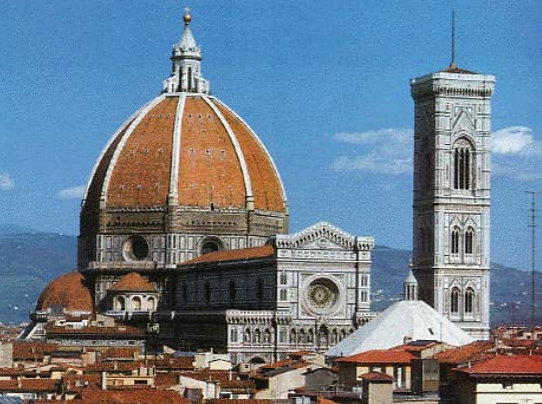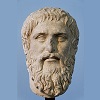12.26: The European Renaissance
- Page ID
- 12856
No intellectual movement can be traced to a single cause. An idea has many parents and even more children. But if we look to the Mediterranean world of the fourteenth century, we can find at least a few causes of an intellectual and cultural movement historians generally call the Italian Renaissance. Renaissance comes from the French word for rebirth. It was an intellectual movement whose ideals were to return to the art, literature, and culture of Ancient Greece and Rome.
Northern Italy was well-suited to allow for the emergence of the Renaissance. Thanks to Mediterranean trade, it was one of the wealthiest and most urbanized regions of Western Europe. It was also politically fragmented so that the princes of its many courts all offered sponsorship to artists and intellectuals. Moreover Italy’s education system had focused more on the literature of Ancient Rome than the rest of Europe, whose scholastic curriculum often focused on logic and philosophy.
.png?revision=1&size=bestfit&width=357&height=511)
In this environment, the Italian poet Francesco Petrarch’s (1307 – 1374) writings prompted a greater interest in the literature of Ancient Rome. This focus on studying literature rather than philosophy and theology is often known as humanism, since poetry and literature were called humanistic studies in medieval schools. Another key element of the humanistic movement was that its proponents believed in studying the ancient texts themselves rather than the centuries of commentaries that had grown up around these texts. These values of returning to the original texts shorn of their commentaries also led to an increase in the study of how the writers of ancient Rome had used the Latin language and even of how Latin style had altered during different times in the Roman Empire’s history.
.png?revision=1&size=bestfit&width=477&height=356)
Originally, humanistic scholars had focused on the study of Latin. But other circumstances soon brought about a greater emphasis on the study of Greek. As the Byzantine Empire crumbled before the Ottoman Turks, many Greek-speaking refugees fleeing the Aegean area settled in Italy, particularly in the city-state of Florence. These refugees brought Greek books with them and founded schools for the study of Greek. In Western Europe after the fall of the Western Roman Empire in the fifth century, the study of Greek had declined As a result, most readers had known of the literature of Ancient Greece, but they had usually only known it in Latin summaries. By the twelfth century, Western Europeans had read the philosophy of Aristotle and the science of Ptolemy, but usually they knew these philosophers only in translations—which had often been translated from Greek to Arabic to Latin.
So a return to the study of Greek meant that scholars were now reading Greek literature in its original language. Manuel Chrysoloras (c. 1350 – 1415) established a school for the study of Greek in Florence. Western Europeans now had direct access to most of the writings of Plato and Homer for the first time in centuries.
.png?revision=1)
This interest in the culture of the ancient world also led to an interest in the art and architecture of Greece and Rome. Churches, such as Santa Maria del Fiore in Florence (built between 1420 and 1436), sprang up in imitation of the domed temples (and churches) of ancient Rome, while sculptors such as Donatello (1386 – 1466) produced naturalistic sculptures the like of which had not been seen in more than a thousand years.
.png?revision=1)
This intellectual movement was not simply an affair of scholars and artists. Indeed, its impacts would be far-reaching throughout Western Europe. The children of princes and wealthy merchants gradually came to be educated along humanistic lines, and the fashion for a humanistic education would eventually spread from Italy to the elites of all Western Europe.
Humanism’s political impacts would be broad ranging as well. Since the eighth century, the popes had relied on the text of the Donation of Constantine in their struggles with the Holy Roman Empire and to demonstrate their right to rule as earthly princes as well as to spiritually direct the Church. In 1440, the humanist scholar Lorenzo Valla (1407 – 1457) analyzed the Donation of Constantine—and showed definitively that it was a forgery. Its Latin writing style was most certainly not the Latin of fourth-century Rome. Valla had shown that one of the foundational documents by which the papacy claimed legitimacy as an earthly power was a fraud.
.png?revision=1)
Even the ideals of how a ruler should govern came under the influence of Renaissance humanism. In his analysis of the historical writings of Ancient Rome, the humanist Niccolò Machiavelli (1469 – 1527) argued that the circumstances of history show that a prince should not necessarily attempt to rule virtuously, but instead should ruthlessly set aside ethics and morality in order to accomplish the goals of the state. One should note that in many ways rulers already behaved this way, but Machiavelli gave an intellectual justification for doing so.
And, of course, an intense study of the language of ancient texts would lead to an intense study of the ancient text that was most important for Western Europe of the later Middle Ages: the Bible. Humanists such as the Dutch scholar Desiderius Erasmus (1469 – 1536) used the tools of linguistic investigation to analyze the Greek text of the New Testament. Other scholars also began looking at the Bible not with the intellectual tools of logic and philosophy, but with linguistic analysis. They began to look at such a text as it had been written, and not at the intervening fourteen centuries of commentary. The results of such reading were explosive.


